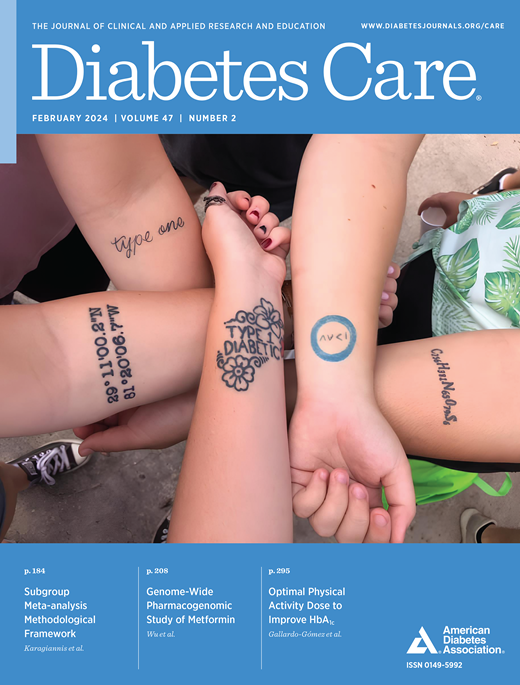Time in Tight Glucose Range in Type 1 Diabetes: Predictive Factors and Achievable Targets in Real-World Users of the MiniMed 780G System
IF 14.8
1区 医学
Q1 ENDOCRINOLOGY & METABOLISM
引用次数: 0
Abstract
OBJECTIVE We studied time in tight range (TITR; 70–140 mg/dL) in real-world users of the MiniMed 780G system (MM780G). RESEARCH DESIGN AND METHODS CareLink Personal data were extracted (August 2020 to December 2022) to examine TITR and its relationship with time in range (TIR; 70–180 mg/dL), factors predicting higher TITR, and which TITR target is a reasonable treatment goal. RESULTS The 13,461 users (3,762 age ≤15 years and 9,699 age >15 years) showed an average TITR of 48.9% in those age ≤15 years and 48.8% in the older group (vs. TIR 71.2% and 73.9%, respectively). Consistent use of a glucose target (GT) of 100 mg/dL and active insulin time (AIT) of 2 h were the most relevant factors predicting higher TITR (P < 0.0001). In users consistently applying these optimal settings, TITR was 56.7% in those age ≤15 years and 57.0% in the older group, and the relative impact of these settings on TITR was 60% and 86% greater than that on TIR, respectively. TITRs of ∼45% (age ≤15 years 46.3% and older group 45.4%), ∼50% (50.7% and 50.7%) and ∼55% (56.4% and 58.0%) were best associated with glucose management indicators <7.0%, <6.8%, and <6.5%, respectively. TITRs of >45%, >50%, and >55% were achieved in 91%, 74%, and 55% of those age ≤15 years and 93%, 81%, and 57% of older group users, respectively, at optimal settings. CONCLUSIONS This study demonstrates that 1) mean TIR is high with a high mean TITR in MM780G users (>48%), 2) consistent use of optimal GT/AIT improves TITR (>56%), 3) the impact of these settings on TITR is larger than on TIR, and 4) a TITR target >50% is our suggested treatment goal.1 型糖尿病患者血糖控制在严格范围内的时间:MiniMed 780G 系统实际用户的预测因素和可实现目标
目的 我们研究了 MiniMed 780G 系统(MM780G)实际用户的血压紧张范围时间(TITR;70-140 mg/dL)。研究设计和方法 提取 CareLink 个人数据(2020 年 8 月至 2022 年 12 月),研究 TITR 及其与在量程内时间(TIR;70-180 mg/dL)的关系、预测较高 TITR 的因素以及哪个 TITR 目标是合理的治疗目标。结果 13,461 名用户(3,762 名年龄小于 15 岁,9,699 名年龄大于等于 15 岁)显示,年龄小于 15 岁组的平均 TITR 为 48.9%,年龄较大组的平均 TITR 为 48.8%(对比 TIR 分别为 71.2% 和 73.9%)。持续使用 100 mg/dL 的目标血糖 (GT) 和 2 小时的有效胰岛素时间 (AIT) 是预测较高 TITR 的最相关因素(P < 0.0001)。在坚持使用这些最佳设置的用户中,年龄小于 15 岁组的 TITR 为 56.7%,年龄大于 15 岁组的 TITR 为 57.0%,这些设置对 TITR 的相对影响分别比对 TIR 的影响大 60% 和 86%。与血糖管理指标<7.0%、<6.8%和<6.5%最相关的TITR分别为∼45%(年龄≤15岁为46.3%,老年组为45.4%)、∼50%(50.7%和50.7%)和∼55%(56.4%和58.0%)。在最佳设置下,91%、74% 和 55% 的 15 岁以下人群以及 93%、81% 和 57% 的老年群体用户的 TITR 分别达到了 >45%、>50% 和 >55%。结论 本研究表明:1)MM780G 用户的平均 TIR 高,平均 TITR 也高(>48%);2)持续使用最佳 GT/AIT 可提高 TITR(>56%);3)这些设置对 TITR 的影响大于对 TIR 的影响;4)我们建议的治疗目标是 TITR 目标值>50%。
本文章由计算机程序翻译,如有差异,请以英文原文为准。
求助全文
约1分钟内获得全文
求助全文
来源期刊

Diabetes Care
医学-内分泌学与代谢
CiteScore
27.80
自引率
4.90%
发文量
449
审稿时长
1 months
期刊介绍:
The journal's overarching mission can be captured by the simple word "Care," reflecting its commitment to enhancing patient well-being. Diabetes Care aims to support better patient care by addressing the comprehensive needs of healthcare professionals dedicated to managing diabetes.
Diabetes Care serves as a valuable resource for healthcare practitioners, aiming to advance knowledge, foster research, and improve diabetes management. The journal publishes original research across various categories, including Clinical Care, Education, Nutrition, Psychosocial Research, Epidemiology, Health Services Research, Emerging Treatments and Technologies, Pathophysiology, Complications, and Cardiovascular and Metabolic Risk. Additionally, Diabetes Care features ADA statements, consensus reports, review articles, letters to the editor, and health/medical news, appealing to a diverse audience of physicians, researchers, psychologists, educators, and other healthcare professionals.
 求助内容:
求助内容: 应助结果提醒方式:
应助结果提醒方式:


